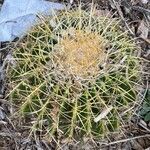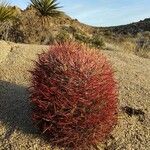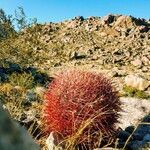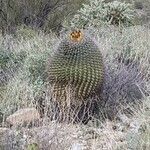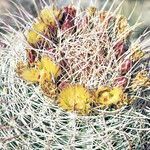Stems straight, erect or nearly so (or leaning), cylindric, (20-)45-150(-300) × (20-)25-40(-50) cm; ribs (18-)21-31, shallowly notched immediately above each areole. Spines 12-32 per areole, central spines and larger radial spines whitish, yellow, pink, dull red, or brown; smallest spines per areole slender, sometimes bristlelike, less than 1 mm diam. (rarely absent); central spines 4 per areole, major rigid central spines surrounded by weaker subcentral spines; principal central spine moderately curved, sometimes twisted, usually not strongly hooked except on relatively young plants, annulate, adaxial surface usually flat or even concave, 36-140[-170] × 2-4.5 mm. Flowers maroon outside, yellow inside, 3-6 × 4-6 cm; inner tepals commonly yellow, (rarely with reddish midstripes, very rarely orange to red with a darker red midstripes); stigma lobes yellow (to red). Fruits ± readily dehiscent through basal pore, bright yellow (very rarely reddish), 30-40(-50) × 15-20 mm, leathery or fleshy, locule dry, hollow except for seeds. Seeds (1.5-)2-3 mm, pitted. 2n = 22.
More
A cactus. It occurs singly. The stems are oval and become cylinder shaped. They are 3 m tall and 80 cm across. There are 13-27 ribs. The spine spots are about 2 cm apart. There are 9-13 reddish spines which radiate out. These are 4 cm long. There are 1-4 spines in the centre. These are 12 cm long. The flowers are yellow or orange. They are about 5 cm long. The fruit are round and yellow and 3 cm long.
Rocky slopes on the mountain ranges of the desert, sometimes on the plains, and on gravelly or rocky hillsides, canyon walls, and alluvial fans; at elevations up to 1,750 metres.
More
It is a Mediterranean climate plant. Desert. It needs a sunny site. It needs a temperature above 10°C. It can grow in arid places.
The seeds are eaten roasted. They are also ground into a meal. The fruit are eaten raw, dried or made into syrup. The syrup is also fermented into an alcoholic drink. Caution: Alcohol is a cause of cancer. The sap from the stem is scooped out and the juice squeezed out. The pulp of the stem is used to make cactus candy.
